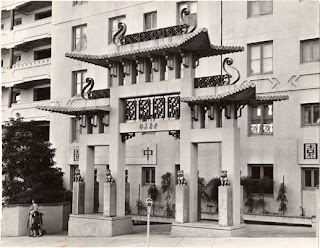 |
| The Ping Yuen Public Housing Project in 1956 (San Francisco Public Library, Historical Photo Collection) |
Chinese Americans faced appalling discrimination in San Francisco prior to World War II. Hemmed into Chinatown’s crowded, substandard housing, San Francisco’s Chinese population faced discrimination in employment, housing, and public accommodations, hostility from police and public health officials, and violence from bigoted demagogues who stoked white working class fears about competition for jobs. While San Francisco’s tiny African American community (less than 5000 people prior to the War) faced discrimination, it was not subject to the extreme race hatred and bigotry that marked relations between the white and Asian communities.
The 1940s saw a dramatic shift in this racial dynamic. Both the image and the fortunes of the Chinese American community changed as the decade progressed. White Americans came to view the community differently. The Chinese had been loyal allies during the War – heroic resisters of Japanese aggression. After the War, most of those living in the United States were staunch supporters of the Kuomintang and thus stood at the forefront of the anti-communist struggle against “Red” China. This status as war heroes and cold warriors led to a dramatic decline in anti-Chinese sentiment. It also resulted in tangible benefits for the Chinese American community, such as a loosening of restrictions on immigration, political appointments for Chinese Americans, and the provision of government benefits targeted specifically at their communities. In San Francisco, it meant access to local political power, including patronage positions in local government, and the building of the Ping Yuen public housing project in Chinatown. At the same time, African Americans’ position in the racial hierarchy shifted. As African Americans streamed into the city in increasing numbers, hostility towards them grew. Discrimination in employment increased, as did housing and educational segregation, and police hostility. As historian Scott Tang has elegantly written, in postwar California, African Americans replaced Chinese Americans as the “new objects of racial scorn.”
This shifting racial dynamic was played out in a fascinating manner in the litigation that the NAACP brought to desegregate San Francisco’s public housing, a case known as Banks v. Housing Authority. Prior to 1950, the San Francisco Housing Authority segregated its public housing by race. Whites lived in projects in white neighborhoods and African Americans lived in a single project in the Western Addition. Immediately after World War II, the Housing Authority built two more housing projects, North Beach Place in the predominantly Italian North Beach neighborhood and the Ping Yuen apartments in Chinatown. According to the Housing Authority’s “neighborhood pattern” policy, only Italian Americans would be allowed to live in North Beach Place and only Chinese Americans would be admitted to Ping Yuen. Every racial and ethnic group in the city would be given a number of public housing slots proportional to the need for public housing in their community. Thus, the distribution of public housing would be equal among the different communities, but it would be separate.
Prior to the World War II, San Francisco’s African American community didn’t object to this approach. Indeed, at that time, the city’s African American elites didn’t demand that the Housing Authority integrate its properties. They simply asked that it build them “their own” public housing in the Western Addition. Thus, when the Westside Courts opened in 1943, the African American community considered it to be a political victory. By the late 1940s, however, civil rights groups had turned decisively against the “separate but equal” premise of the demand to build Westside Courts. Consequently, in 1951, the NAACP sued the Housing Authority, asserting that the neighborhood pattern policy violated the Equal Protection Clause of the Fourteenth Amendment.
For the details of the lawsuit and its controversial aftermath, stay tuned. They will be the subject of my next post.
This shifting racial dynamic was played out in a fascinating manner in the litigation that the NAACP brought to desegregate San Francisco’s public housing, a case known as Banks v. Housing Authority. Prior to 1950, the San Francisco Housing Authority segregated its public housing by race. Whites lived in projects in white neighborhoods and African Americans lived in a single project in the Western Addition. Immediately after World War II, the Housing Authority built two more housing projects, North Beach Place in the predominantly Italian North Beach neighborhood and the Ping Yuen apartments in Chinatown. According to the Housing Authority’s “neighborhood pattern” policy, only Italian Americans would be allowed to live in North Beach Place and only Chinese Americans would be admitted to Ping Yuen. Every racial and ethnic group in the city would be given a number of public housing slots proportional to the need for public housing in their community. Thus, the distribution of public housing would be equal among the different communities, but it would be separate.
Prior to the World War II, San Francisco’s African American community didn’t object to this approach. Indeed, at that time, the city’s African American elites didn’t demand that the Housing Authority integrate its properties. They simply asked that it build them “their own” public housing in the Western Addition. Thus, when the Westside Courts opened in 1943, the African American community considered it to be a political victory. By the late 1940s, however, civil rights groups had turned decisively against the “separate but equal” premise of the demand to build Westside Courts. Consequently, in 1951, the NAACP sued the Housing Authority, asserting that the neighborhood pattern policy violated the Equal Protection Clause of the Fourteenth Amendment.
For the details of the lawsuit and its controversial aftermath, stay tuned. They will be the subject of my next post.